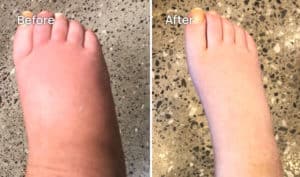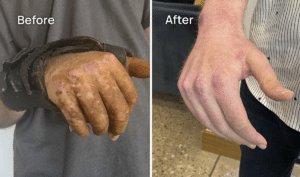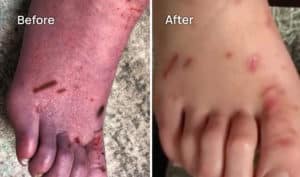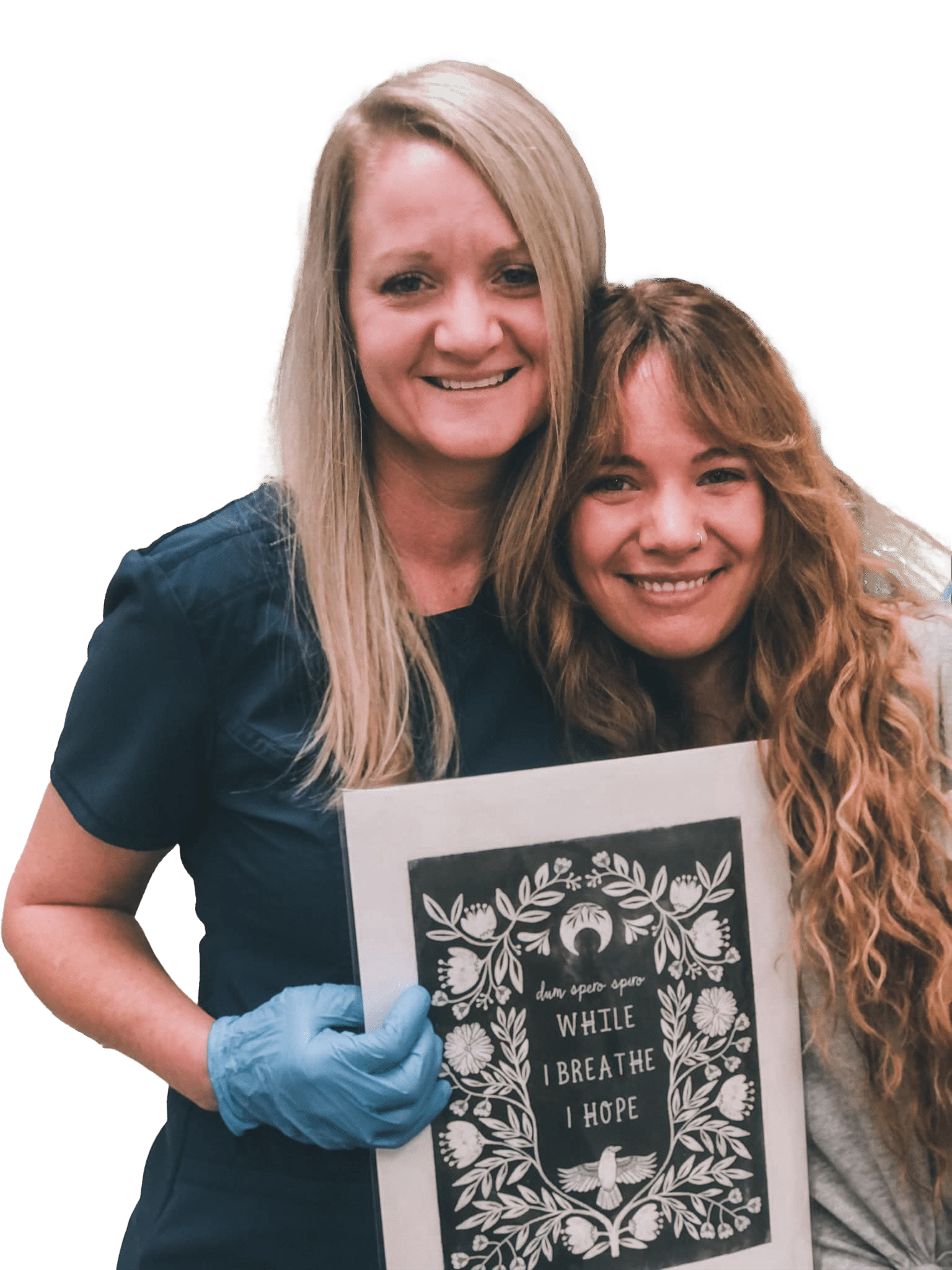A rare neurological disorder, Complex Regional Pain Syndrome (CRPS) is ranked among the most painful diseases and medical problems. CRPS is a condition associated with the imbalance and malfunction of the autonomic nervous system and is often referred to as “the suicide disease” because there is technically no “cure” and limited effective treatments.
Complex Regional Pain Syndrome was also ranked in the Top 10 Most Painful Medical Conditions by The U.S. News Health team.
It is a chronic disease that often worsens over time. Alarmingly, 35 percent of sufferers eventually report symptoms throughout the body. The disease may remain localized, spread slowly over years, or progress rapidly like a wildfire out of control.
Because CRPS is so painful, patients who suffer from it will mostly pay little attention to any other symptoms or health conditions they may be suffering from, in my experience. CRPS is like a blinding white light, obliterating anything else. Patients who suffer from CRPS experience pain differently from other people. The average CRPS patient will barely blink at even a migraine. While you are suffering from CRPS, and you have this ‘super power’ that allows your brain to ignore pain and other symptoms that simply cannot compete with the raging pain of CRPS, you may not pay attention to what is commonly referred to as “coconcurrent’ conditions, which are conditions you suffer from in addition to CRPS. These conditions may also harm your health, and definitely deserve your attention.
Because of the complexity of the nervous system dysfunction responsible for CRPS, the patient will often suffer from other conditions and symptoms also related to the same nervous system dysfunction.
A common condition that CRPS patients often suffer from is Trigeminal neuralgia (also known as tic douloureux), a nerve disorder that causes sharp, sudden, searing, electric-shock-like facial pains. Many experts say this condition is the most unbearably painful human condition, and for this reason, like CRPS, it is also tragically also known as “the suicide disease”. It affects about one out of every fifteen thousand people, although it is much more common among those who also suffer from CRPS. The pain comes from a cranial nerve called the trigeminal nerve and usually affects one side of the lower face and jaw, although symptoms may appear near the eyes, ears, nose, jaw, or lips.
Trigeminal neuralgia has been linked with autonomic nervous system dysfunction. In addition, at least one study has linked it to upper cervical trauma such as whiplash injuries. Medically, this condition is treated with medications or surgery. We believe that this condition must be approached in such a way that the autonomic nervous system dysfunction is balanced and corrected. In addition, we correct any upper cervical misalignment present and rehabilitate the trigeminal nerve in our treatment approach.
The most common co-existing conditions with CRPS are:
While the above list is not all- inclusive, it covers many of the other symptoms that CRPS may suffer from. Keep in mind that an abnormal Autonomic Nervous System (ANS) may affect all kinds of other systems in the body. Whatever you suffer from, always try to trace it back to the Central Nervous System, thinking about your symptoms in a logical way, instead of just allowing your doctor to treat the symptom with a drug.
It is difficult to find exact statistics on CRPS and suicide rates. Unfortunately, ninety percent of the CRPS patients at Spero Clinic have admitted that at one point or another, the thought of ending it all crossed their mind at least once. The thing about chronic pain is that it tends to drive you a little nutty over time. It makes problems seem larger than life, it causes depression, and it wears down your defenses. It is of our opinion that CRPS is NOT a hopeless disease.
It is my firm belief that in addition to medical support, every CRPS patient as well as their close family members need emotional support. While family and also individual counseling can prove invaluable, it is not always within everyone’s financial reach. However, support may come in many different shapes and forms. Once again, the Internet can prove to be an indispensable tool. In order to receive help, you must reach out and ask for it. No matter what stage of hardship you are in, there will always be someone who has been there, done that. People are usually very willing to help if only you ask.
In addition, your family members may reach out to other family members in the same position they are in. Further on in this chapter, we will discuss family relationships in more detail. However, before we move on to the next topic, I have to make sure that you truly hear me in your heart when I say this: Please reach out to someone the moment you find yourself considering even for a moment the possibility of ending your life.
Thoughts are like your mind taking a walk. The first time you think a thought, you are cutting a new path across unchartered neurologic fields. Every time you subsequently think that thought, you are forming a footpath that eventually becomes a broad paved road. This road becomes familiar over time, easier and easier to travel on. Do not allow this to happen to you. Do not allow yourself to make a decision that you can never take back when the proverbial night is at its darkest and you are all alone and your thoughts are driven by screaming pain. Those around you who you will leave behind depend on you for their very happiness and sanity to not walk down that road.
National US Suicide Prevention Hotline: 1-800-273-8255. Anytime, 24/7.
Go to www.suicide.org/international-suicide-hotlines.html for international Suicide Prevention Hotlines listed by country.
The debilitating pain caused by CRPS is generally described by patients as aching, burning, bone-crushing pain in the affected areas of the body. The pain is all-consuming, not merely nagging. Things that should not cause pain under normal circumstances (for example, the light brush of fabric or wind) may cause a person who suffers from CRPS intense pain.



View the Patient CRPS Before/After Gallery
This is an extremely subjective and sensitive topic. When the word “cure” is used, that brings to mind visions of a miracle pill, injection, surgery, or perhaps a promising double-blind study excitedly announced by the media. Please believe me when I tell you that it probably won’t happen that way. The failure in finding such a “cure” lies in the theory of what CRPS is or what it is caused by. It is a complex problem, not a puzzle with a single solution. It is not a condition that can be healed by a miracle chemical; it is a body where a whole bunch of things went wrong. CRPS must be approached by a method where every system involved is checked and rebuilt, if necessary, in a systematic way.
The typical CRPS patient has been to many, many different doctors. They have navigated a maze of hospitals, clinics, and specialists that most people cannot even begin to imagine the sheer volume of. They have been prodded, poked, stabbed (ill-advised for CRPS patients), and misdiagnosed many times. Chances are, they have been at least suspected (if not outright accused) of being pill-seeking junkies or malingering (a fancy medical word that basically means you are lying about your pain and symptoms.)
The average CRPS patient will go misdiagnosed or undiagnosed for years before they are lucky enough to find out what is wrong with them. Many figure it out on their own with the help of the Internet and have to then set out to prove it to their doctors.
The majority of our patients report major pain relief. If you are experiencing chronic nerve pain and are at the point of giving up please believe us when we say there is hope. At The Spero Clinic you will find a community of people going through the same pain. We’re here to support you and encourage healing. When a patient completes their treatment they ring the bell to let the world know they’ve met their goal. Your life is still worth living.
To learn more about The Spero Clinic’s CRPS neurologic rehabilitation program, give us a call at 479-304-8202 or click here to book your free consultation with a CRPS specialist today.


View our page Does Remission Last? After surviving chronic pain, many of our patients find that they have a new sense of gratitude and desire to live their lives to the absolute fullest.
 Dr. Katinka: practices in Fayetteville, Arkansas. She has gained a worldwide reputation for her holistic and innovative approach to treating chronic pain by applying groundbreaking technology and techniques. Her program has generated an unprecedented success rate helping patients where all other treatments have failed.
Dr. Katinka: practices in Fayetteville, Arkansas. She has gained a worldwide reputation for her holistic and innovative approach to treating chronic pain by applying groundbreaking technology and techniques. Her program has generated an unprecedented success rate helping patients where all other treatments have failed.
“I’ve created the clinic that I’ve always dreamt about and we have been changing lives, one at a time. To us, every patient counts, every person matters.”
Dr. Katinka: “I remember when I met my first ever patient with Complex Regional Pain Syndrome (CRPS) – his name was Carlos – and I knew that in that moment my life was forever changed. It was the first time I had heard of this condition, and I had no idea that this chance meeting would spark something in me – an endless drive to help people suffering from CRPS. I’ve worked with hundreds of people, with many different conditions, but I’ve never seen the amount of pain and suffering CRPS Warriors endure on a daily basis.”
“I’m passionate about what we do – and I’ve seen our treatments cause miracles over and over and over again. And now, we want to reach more people. There are too many people out there living without hope, without a future – and I know that we can help them. This condition CAN be beaten. There is a new hope for CRPS. And it can be found at The Spero Clinic.”
Experience nerve pain relief with the latest science at The Spero Clinic. Watch the Finding Hope Documentary to learn more about how patients with CRPS and other types of nerve pain find relief.
The Spero Clinic offers various types of treatments and designs each program specifically for each patient. The treatments available at our clinic include:
If you or a loved one is suffering from Neurological Dysfunction, nerve pain, complex regional pain syndrome (CRPS), postural orthostatic tachycardia (POTS), ehlers danlos syndrome (EDS), fibromyalgia, long COVID, or Gastroparesis, there is hope!
Regardless of how long you’ve had chronic pain or how you’ve been treated before, it is possible to thrive again. You are not broken beyond repair. Your body is amazing and capable of healing! Our treatment process is not focused on managing nor suppressing pain. We do not feel like that approach is a permanent sustainable solution. The goal of our treatment is to rehabilitate the Central Nervous System, allowing the body to heal from within.
Contact us via our online form, call (479) 304-8202, or book your FREE CRPS consultation to speak with a specialist about how we can help.

Start your patient journey with the Spero Clinic's neurologic rehabilitation program.
